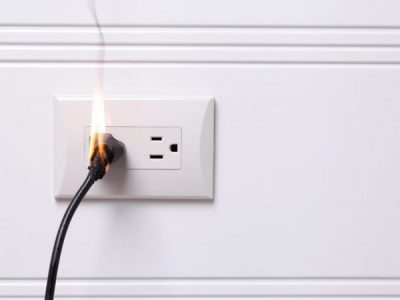Handling some home wiring yourself? Be cautious! Common electrical wiring mistakes result in injury or even fire. Here are 5 common electrical wiring mistakes to avoid (or correct). Don’t forget, you can get a licensed electrician to help:

Overloading leads to overheating of circuit components (including wires) and can cause fire. Credit: OSHAcademy Occupational Safety and Health Training
1. Circuit Overload
PROBLEM: Sometimes circuits trip when two appliances run at once. They’re getting more electricity than they can handle. This is dangerous. Therefore, circuits must be designed to handle the device(s).
FIX IT: When wiring, it’s about how much power your electronics require versus how much circuits can handle. Plan ahead. Add extra circuits – or high capacity circuits for high-powered devices.
2. Not Grounded
PROBLEM: Wiring in older homes isn’t usually grounded. But it should be! This protects from severe electric shock by conducting energy to the ground, rather than the outlet.
FIX IT: Update ungrounded wiring by having GFCI (ground fault circuit interrupter) outlets installed. As a result, three-prong outlets contain a live port, a neutral port, and a ground port to prevent shock.
3. Short Wires
PROBLEM: Wires should not be stretched to make a connection. The length of a wire is crucial to a proper connection. Because of this, poor connections introduce significant risk of injury and fire.
FIX IT: Allow three inches of wire to protrude from the junction box to ensure a safe connection.
4. Overfilled Electrical Box
PROBLEM: The National Electrical Code (NEC) is specific about the number of wires that can safely be housed in a junction box. Live wires produce heat and can be hazardous.
FIX IT: Purchase a larger box before overfilling it. Otherwise, you run the risk of overheating and fire.
5. Unprotected Cables
PROBLEM: If cables are unprotected, especially under ceiling or wall framing, they can be easily damaged. This is a safety concern, and cable protection is included in the NEC residential electrical requirements.
FIX IT: For this reason, install a 1 to 1 ½ inch-thick board alongside cables protects them.




